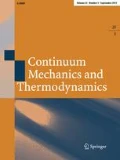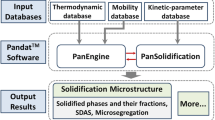Abstract
We employ a free energy density for Mg–Al alloys that is dependent on concentration, strain, and temperature, and derived from quantum mechanical calculations by Ghosh & Bhattacharya (Acta Mater 193:28–39, 2020) , to model the dynamic precipitation of the Mg\(_{17}\)Al\(_{12}\) phase during creep experiments in Mg–Al alloys. Our calculations show that the overall volume fraction of the dynamically formed precipitates is influenced by stress, and furthermore, this influence is anisotropic and asymmetric. Specifically, when the stress is volumetric or along the c-axis direction, the volume fraction of the precipitate phase is greater in compression and lower in tension. Surprisingly, stress along the a- or b-axis directions does not alter the volume fraction of the precipitates. The resistance to creep is improved by the presence of finely dispersed precipitates with a small aspect ratio, closer to spherical or ellipsoidal in shape and high number density. A greater volume fraction of these fine particles are produced during compressive creep tests than tensile creep experiments and thereby explaining the higher creep rate observed in tension than in compression in these alloys. Overall, our calculations explain the tension–compression asymmetry of the creep rate observed in creep experiments in Mg–Al alloys (Agnew et al. in Magn Technol 2000:285–290, 2000; Agnew et al. in Magn. Alloys Appl. 685–692, 2000).






Similar content being viewed by others
Notes
Alternatively, a neural network can be used to define the mapping from strain tensor to the energy [44].
We refer the reader to Ref. [45] for an exposition on third-order elastic moduli for modeling the nonlinear response of crystalline solids.
This data corresponds to a die cast polycrystalline AM60B alloy, where the sub-grain microstructure consists of as cast eutectic Mg\(_{17}\)Al\(_{12}\) phase which is large sized and is surrounded by Mg solid solution. Small particles of the Mg\(_{17}\)Al\(_{12}\) were observed during service at elevated temperatures.
References
Kainer, K.U., Mordike, B.L.: Magnesium alloys and their applications. Wiley-VCH Weinheim, Germany (2000)
Nie, J.-F.: Precipitation and hardening in magnesium alloys. Metall. Mater. Trans. A 43(11), 3891–3939 (2012)
Polmear, I.J.: Magnesium alloys and applications. Mater. Sci. Technol. 10(1), 1–16 (1994)
Agnew, S.R., Liu, K.C., Kenik, E.A., Viswanathan, S.: Tensile and compressive creep behavior of die cast magnesium alloy am60b. Magn. Technol. 2000, 285–290 (2000)
Agnew, S.R., Viswanathan, S., Payzant, E.A., Han, Q., Liu, K.C., Kenik, E.A.: Tensile and compressive creep behavior of magnesium die casting alloys containing aluminum. In: Kainer, K.U. (Ed.) Magnesium Alloys and their Applications (2000)
Nayeb-Hashemi, A.: Phase diagrams of binary magnesium alloys. ASM International, Metals Park, Ohio 44073, USA, 1988. 370 (1988)
Nembach, E.: Particle strengthening of metals and alloys. Wiley, New York (1997)
Nie, J.F.: Effects of precipitate shape and orientation on dispersion strengthening in magnesium alloys. Scr. Mater. 48(8), 1009–1015 (2003)
Ma, X.L., Prameela, S.E., Yi, P., Fernandez, M., Krywopusk, N.M., Kecskes, L.J., Sano, T., Falk, M.L., Weihs, T.P.: Dynamic precipitation and recrystallization in mg-9wt.%Al during equal-channel angular extrusion: A comparative study to conventional aging. Acta Mater. 172, 185–199 (2019)
Prameela, S.E., Yi, P., Medeiros, B., Liu, V., Kecskes, L.J., Falk, M.L., Weihs, T.P.: Deformation assisted nucleation of continuous nanoprecipitates in mg-al alloys. Materialia 9, 100583 (2020)
Lloyd, J.T., Matejunas, A.J., Becker, R., Walter, T.R., Priddy, M.W., Kimberley, J.: Dynamic tensile failure of rolled magnesium: simulations and experiments quantifying the role of texture and second-phase particles. Int. J. Plast. 114, 174–195 (2019)
Avedesian, M.M., Baker, H., eds.: ASM specialty handbook: magnesium and magnesium alloys. ASM Int. (1999)
Caceres, C.H., Davidson, C.J., Griffiths, J.R., Newton, C.L.: Effects of solidification rate and ageing on the microstructure and mechanical properties of az91 alloy. Mater. Sci. Eng. A 325(1–2), 344–355 (2002)
Maitrejean, S., Veron, M., Brechet, Y., Purdy, G.R.: Morphological instabilities in Mg-7.7 at% Al. Scr. Mater. 41(11) (1999)
Nie, J.F., Xiao, X.L., Luo, C.P., Muddle, B.C.: Characterisation of precipitate phases in magnesium alloys using electron microdiffraction. Micron 32(8), 857–863 (2001)
Park, S.S., You, B.S.: Low-temperature superplasticity of extruded mg-sn-al-zn alloy. Scr. Mater. 65(3), 202–205 (2011)
Zhang, J., Dou, Y., Zhang, B., Luo, X.: Elevated-temperature plasticity and mechanical properties of a rare earth-modified mg-zn-al alloy. Mater. Lett. 65(6), 944–947 (2011)
Máthis, K., Gubicza, J., Nam, N.H.: Microstructure and mechanical behavior of az91 mg alloy processed by equal channel angular pressing. J. Alloys Compd. 394(1–2), 194–199 (2005)
Prameela, E.S., Yi, P., Falk, M.L., Weihs, T.P.: Strategic control of atomic-scale defects for tuning properties in metals. Nat. Rev. Phys. 3(3), 148–149 (2021)
https://creativecommons.org/licenses/by/4.0/legalcode. Accessed from 29 Jun 2021
Humble, P.: Towards a cheap creep resistant magnesium alloy. Mater. Forum 21, 45–56 (1997)
Dargusch, M.S., Dunlop, G.L., Pettersen, K., Mordike, B.L., Kainer, K.U.: Magnesium alloys and their applications. In: Mordike, B.L., Kainer K.U. (Eds.), Proc. Volume sponsored by Volkswagen AG. Werkstoff-Informationsgesellschaft, Frankfurt, Germany, pages 277–282, (1998)
Ghosh, S., Bhattacharya, K.: Influence of thermomechanical loads on the energetics of precipitation in magnesium aluminum alloys. Acta Mater. 193, 28–39 (2020)
Hohenberg, P., Kohn, W.: Inhomogeneous electron gas. Phys. Rev. 136, B864–B871 (1964)
Kohn, W., Sham, L.J.: Self-consistent equations including exchange and correlation effects. Phys. Rev. 140, A1133–A1138 (1965)
Jones, R.O., Gunnarsson, O.: The density functional formalism, its applications and prospects. Rev. Mod. Phys. 61, 689–746 (1989)
Kohn, W., Becke, A.D., Parr, R.G.: Density functional theory of electronic structure. J. Phys. Chem. 100(31), 12974–12980 (1996)
Jones, R.O.: Density functional theory: its origins, rise to prominence, and future. Rev. Modern Phys. 87(3), 897 (2015)
Ziegler, T.: Approximate density functional theory as a practical tool in molecular energetics and dynamics. Chem. Rev. 91(5), 651–667 (1991)
Kresse, G., Furthmüller, J.: Efficient iterative schemes for ab initio total-energy calculations using a plane-wave basis set. Phys. Rev. B 54, 11169–11186 (1996)
Gonze, X., Rignanese, G.M., Verstraete, M., Beuken, J.M., Pouillon, Y., Caracas, R., Jollet, F., Torrent, M., Zerah, G., Mikami, M., Ghosez, P., Veithen, M., Raty, J.Y., Olevano, V., Bruneval, F., Reining, L., Godby, R., Onida, G., Hamann, D.R., Allan, D.C.: Zeitschrift für Kristallographie, 220(5-6):558–562, (2005). \(\copyright \) 2005 Oldenbourg Wissenschaftsverlag. Published in Zeitschrift für Kristallographie and uploaded in accordance with the publisher’s self archiving policy
Giannozzi, P., Baroni, S., Bonini, N., Calandra, M., Car, R., Cavazzoni, C., Ceresoli, D., Chiarotti, G.L., Cococcioni, M., Dabo, I., et al.: Quantum espresso: a modular and open-source software project for quantum simulations of materials. J. Phys. Condens. Matter 21(39), 395502 (2009)
Motamarri, P., Das, S., Rudraraju, S., Ghosh, K., Davydov, D., Gavini, V.: Dft-fe-a massively parallel adaptive finite-element code for large-scale density functional theory calculations. Comput. Phys. Commun. 246, 106853 (2020)
Saad, Y., Chelikowsky, J.R., Shontz, S.M.: Numerical methods for electronic structure calculations of materials. SIAM Rev. 52(1), 3–54 (2010)
Zhou, Y., Saad, Y., Tiago, M.L., Chelikowsky, J.R.: Self-consistent-field calculations using chebyshev-filtered subspace iteration. J. Comput. Phys. 219(1), 172–184 (2006)
Ghosh, S., Suryanarayana, P.: Sparc: accurate and efficient finite-difference formulation and parallel implementation of density functional theory: Isolated clusters. Comput. Phys. Commun. 212, 189–204 (2017)
Ghosh, S., Suryanarayana, P.: Sparc: accurate and efficient finite-difference formulation and parallel implementation of density functional theory: Extended systems. Comput. Phys. Commun. 216, 109–125 (2017)
Serebrinsky, S., Carter, E.A., Ortiz, M.: A quantum-mechanically informed continuum model of hydrogen embrittlement. J. Mech. Phys. Solids 52(10), 2403–2430 (2004)
Reina, C., Marian, J., Ortiz, M.: Nanovoid nucleation by vacancy aggregation and vacancy-cluster coarsening in high-purity metallic single crystals. Phys. Rev. B 84(10), 104117 (2011)
Gavini, V.: Role of macroscopic deformations in energetics of vacancies in aluminum. Phys. Rev. Lett. 101(20), 205503 (2008)
Gavini, V.: Role of the defect core in energetics of vacancies. In: Proceedings of the Royal Society A: Mathematical, Physical and Engineering Sciences 465(2110), 3239–3266 (2009)
Ghosh, S., Suryanarayana, P.: Electronic structure study regarding the influence of macroscopic deformations on the vacancy formation energy in aluminum. Mech. Res. Commun. 99, 58–63 (2019)
Busk, R.S.: Lattice parameters of magnesium alloys. Jom 2(12), 1460–1464 (1950)
Shi Teh, Y., Ghosh, S., Bhattacharya, K.: Machine-learned prediction of the electronic fields in a crystal. arXiv preprint arXiv:2104.03831, (2021)
Hearmon, R.F.S.: Third-order elastic coefficients. Acta Crystallogr. 6(4), 331–340 (1953)
Han, G., Han, Z., Luo, A.A., Liu, B.: Three-dimensional phase-field simulation and experimental validation of \(\beta \)-mg 17 al 12 phase precipitation in mg-al-based alloys. Metall. Mater. Trans. A 46(2), 948–962 (2015)
Payzant, E.A., Agnew, S.R., Han, Q., Viswanathan, S.: Mg17al12 phase precipitation kinetics in die casting alloys az91d and am60b. Magn. Technol. 2001, 183–187 (2001)
Nikolaevich Kolmogorov, A.: On the statistical theory of the crystallization of metals. Bull. Acad. Sci. USSR Math. Ser 1(3), 355–359 (1937)
Avrami, M.: Kinetics of phase change. i general theory. J. Chem. Phys. 7(12), 1103–1112 (1939)
Johnson, W.A.: Reaction kinetics in processes of nucleation and growth. Am. Inst. Min. Metal. Petro. Eng. 135, 416–458 (1939)
Ghosh, S., Bhattacharya, K.: Spectral quadrature for the first principles study of crystal defects: Application to magnesium. arXiv preprint arXiv:2011.13517, (2020)
Acknowledgements
I would like to thank Professor Kaushik Bhattacharya (California Institute of Technology) for his mentorship. I would like to acknowledge Professor Sean Agnew (University of Virginia) for bringing to my notice the experimental work related to the asymmetric creep performance of Magnesium–Aluminum alloys. I also thank the anonymous reviewers for their valuable comments and suggestions. Part of this research was performed when I had held a position at the California Institute of Technology. I gratefully acknowledge funding in part from the Army Research Laboratory under Cooperative Agreement Number W911NF-12-2-0022. Some of the computations were conducted in the Resnick High Performance Center, a facility supported by Resnick Sustainability Institute at the California Institute of Technology. This research used resources of the Oak Ridge Leadership Computing Facility, a DOE Office of Science User Facility operated by the Oak Ridge National Laboratory under contract DE-AC05-00OR22725.
Author information
Authors and Affiliations
Corresponding author
Additional information
Communicated by Andreas Oechsner.
Publisher's Note
Springer Nature remains neutral with regard to jurisdictional claims in published maps and institutional affiliations.
This manuscript has been authored in part by UT-Battelle, LLC, under contract DE-AC05-00OR22725 with the US Department of Energy (DOE). The US government retains and the publisher, by accepting the article for publication, acknowledges that the US government retains a nonexclusive, paid-up, irrevocable, worldwide license to publish or reproduce the published form of this manuscript, or allow others to do so, for US government purposes. DOE will provide public access to these results of federally sponsored research in accordance with the DOE Public Access Plan (http://energy.gov/downloads/doe-public-access-plan).
Rights and permissions
About this article
Cite this article
Ghosh, S. Precipitation during creep in magnesium–aluminum alloys. Continuum Mech. Thermodyn. 33, 2363–2374 (2021). https://doi.org/10.1007/s00161-021-01047-7
Received:
Accepted:
Published:
Issue Date:
DOI: https://doi.org/10.1007/s00161-021-01047-7




